Text
Beautiful Coronado National Forest... Boondocking With Horses

My husband and I have been trying to plan our first equine boondocking adventure, and we finally made it happen. We just returned from three nights and four glorious days in Coronado National Forest in St. David, Arizona. We sold the beloved LQ that I brought to the marriage and purchased a new-to-us Class A motorhome. We certainly didn't break any speed records getting that beast back to our camping spot... but we did it! We were close enough to home that we opted to have Alan drive the coach and I pulled the horses with the truck. That allowed me to scope out if our desired spot was available before he took the coach all the way back.
We took a day trip to this location a few weeks ago. Prior to our recent adventure, we hadn't ridden here for several years. I wrote about our first ride in the post titled: Council Rocks in St. David, Arizona. I mentioned in that blog how BUMPY the forest road is, and it is nearly 20 miles back to where we camped. It takes us an hour to get to the forest road, and another hour to go not quite 20 miles! I'm not inclined to rattle the teeth out of the horses, and neither did I want to have to rearrange every single item in the coach.
We arrived around lunchtime on a Tuesday, hoping the park would be less crowded. On our day trip a few weeks ago, we scoped out two great options for our boondocking adventure. Happily, we were able to snag our primo location. While there, we encountered a group of ladies who frequently ride and camp in the area. We learned that we had, indeed, snagged the favorite equestrian camping site.

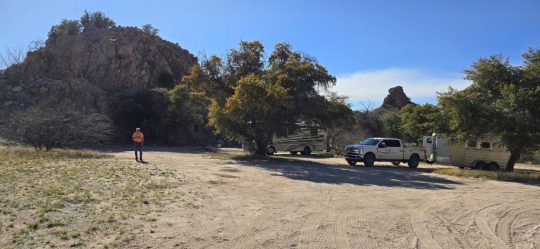
We have used electric fencing multiple times in the past, both while camping and for erecting a temporary grazing fence at our home in Colorado. We had never highlined the horses. Knowing that more boondocking was in our future, I wanted to have highlining as an option. After doing some research, I settled on ordering the Ultimate Highline kit.
We set it up once at home before we left, and it was quite anticlimactic... just what you want with horses! They stood there like the older, mature horses that they are. In fact, I'm not sure my gelding figured out that he had the option of moving on his longer line. His training told him that he was tied so he needed to stay put. He preferred to just hang out with his lady. We were very pleased with the highline setup. When I purchased the base camp set, I also bought a smaller, lighter set to use when on day rides. Additionally, the smaller line will be pressed into service to highline a dog or three or four...
Coronado National Forest
Coronado National Forest covers 1.78 million acres in southeastern Arizona and southwestern New Mexico. The area where we camped is part of the Douglas Ranger District. It used to be that this area was divided into three separately designated National Forests: Chiricahua National Forest, Dragoon National Forest, and Peloncillo National Forest. I have written several blog posts about riding in the Dragoon and Chiricahua Mountains.
Our first ride
By the time we crept down the bumpy road and set up our coach and highline, we opted not to ride on the first day. On our first full day of camping, we headed north on the forest road until we passed Slavin Gulch and the trail split. We took the right fork. I think we were on the Slavin Gulch trail, but I am not sure. However, it was beautiful!
At one point, we passed a parking area where a few people were getting ready to hike. We headed on down the trail ahead of them. We started up a branch of the trail that became way too challenging for the horses. I took a couple of photos and we carefully crept our way back down. We encountered the hikers as they were headed up the trail we had abandoned... to CLIMB the mountain! My Garmin watch died a short distance from camp, so you'll have to fill in the blanks... We walked a short way past camp to water the horses at a creek that still had some running water.

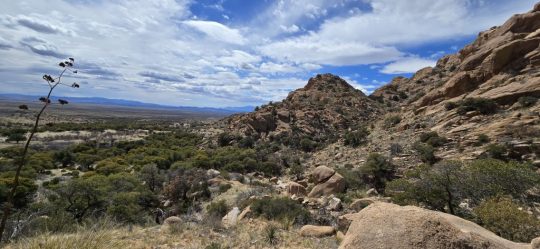
The view before we turned around.

The trail down is visible...
Ride #2
For our second ride, we essentially retraced our ride towards Council Rock. It is a steep climb up to the actual area where the Native Americans "counseled" and it is not a horse-friendly trail. When we rode here in 2020, we had a friend along who held our horses while we climbed up the trail on foot. Nevertheless, it is a beautiful ride through the Dragoon Mountains and some open plains. This is the ride we took on our day trip a few weeks ago.


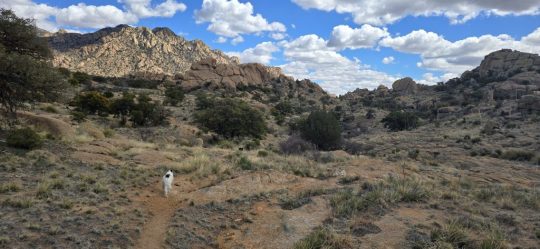
The temperature was 63 degrees but there was a bit of wind that made it chilly enough to need a light coat. We were accompanied on all three of our rides by two of our five dogs. Jake, our recent acquisition from Arizona Border Collie Rescue, is undergoing heartworm treatment and is on major exercise restriction. The other two are too old or have unhappy joints and cannot do the 6 to 7 miles that we covered each day.
Our third and last ride
We rode on the day we broke camp, as the weather was beautiful and no camp host was pushing us out of our spot! This time, we decided to ride away from the mountains and into the flatlands to see what we could discover. We saw one lonely, solitary steer but lots of evidence of cattle in the past. Coronado National Forest apparently allows free range cattle. There are cattle guards on the forest roads. Initially, we saw some evidence of prior horseback riders, but most people apparently ride into the mountains.
There were stock tanks scattered throughout this area. Some were filled, some were not. We rode through a gate or two. We had many options as to where we rode and how far we rode. There were lots of cattle trails and a road or two. We ended up riding through a dry wash with a deep, sandy bottom. We were the only people and horses visible in the vast landscape.
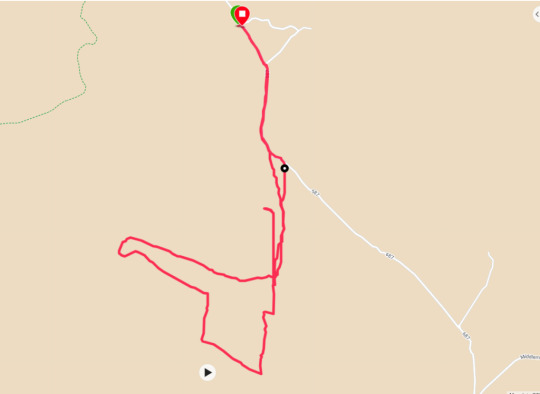
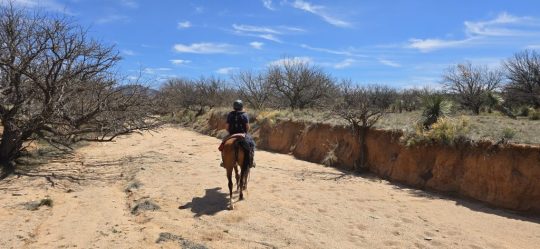


A wonderful time was had by all!
We thoroughly enjoyed our first boondocking-with-horses experience. The horses handled the highline quite well. The dogs did great. Thank heavens for more room in the motorcoach!

I will add that knowing our horses had identification on them at all times gave me a great deal of peace of mind. I don't think we encountered more than a dozen people during our entire four days. I can't imagine waking up to find that one or both horses were not where they were supposed to be, and having to count on a park ranger (we never saw the first one) or some other hikers or campers to find them. What good would a Facebook group be in that scenario?
Should the unthinkable happen and our horses get away from us, at least I know that we can be called immediately when they are found. I would be a nervous wreck if our horses were loose on hundreds of acres of land, but I would also be a lot more confident that we'd eventually get them back.
We are excited to plan future getaways with all of our animals. My gelding turns 22 years old this year. He's definitely slowing down, but I hope we still have many more memories in our future.
Read the full article
0 notes
Text
Boondocking With Horses in Beautiful Coronado National Forest

View On WordPress
0 notes
Text
CIRDC Update...
As I mentioned in this post, a little less than a year ago I began the volunteer position of Vet Resource Coordinator for Arizona Border Collie Rescue. It has been truly enjoyable to “dabble” in veterinary medicine again, and it prompted me to acquire my Arizona veterinary license. In the interest of maintaining my licenses, I am required to complete Continuing Education Units, or CEUs. Recently,…

View On WordPress
0 notes
Text
CIRDC or Canine Infectious Respiratory Disease Complex... Is there A New Bug?

Media outlets of all types have been abuzz lately with growing public concern over the wave of respiratory disease seen in our canine companions. Is this a new disease or an uptick in canine infectious respiratory disease complex, or CIRDC? As a retired veterinarian, but one who is involved in shelter and rescue medicine, I wanted to get some straight answers from some of the respected professionals in my field. To that end, I listened to a seminar hosted by Trupanion, an animal medical insurance company.
Four veterinarians participated in the Trupanion seminar.
- DR. STEVE WEINRAUCH BVMS, MRCVS is the Chief Veterinary/Product Officer of Trupanion. He was the host of the seminar.
- DR. SCOTT WEESE DACVIM is a veterinary internist, a Diplomate of the American College of Veterinary Internal Medicine, and a Fellow of the Canadian Academy of Health Sciences. He is a Professor at the Ontario Veterinary College, University of Guelph, Director of the University of Guelph Centre for Public Health and Zoonoses, Chief of Infection Control at the Ontario Veterinary College Health Sciences Centre, and is a member of numerous national and international committees dealing with infectious diseases and antimicrobial resistance.
- DR. MICHAEL LAPPIN PHD, DACVIM is a veterinary internist, a Diplomate of the American College of Veterinary Internal Medicine, holds a PhD in Parasitology, is Director of the Center for Companion Animal Studies at Colorado State University School of Veterinary Medicine and Chair of the World Small Animal Veterinary Association One Health Committee. He is also currently a Professor at the College of Veterinary Medicine and Biomedical Sciences at Colorado State University.
- DR. CARRIE JURNEY DACVIM is a veterinary neurologist and practice owner at Remedy Veterinary Specialists in San Francisco. She is a passionate advocate for mental health and wellbeing, and serves as the president of Not One More Vet 501(c)(3), the world's largest wellness-focused charity for veterinary professionals.
Dr. Jurney was more of a special guest asking questions on behalf of the "rank and file" veterinary profession. Drs. Lappin and Weese answered most of the questions. I was unable to attend the seminar live but did watch it a couple of hours later. Approximately 8000 people registered for the seminar, of which half were veterinary professionals and half were pet parents. There was an opportunity to submit questions before the seminar. You can listen to the 75-minute seminar yourself by clicking on this link.
What is CIRDC?
Dr. Weese writes a blog titled "Worms & Germs." While I was previously unaware of this resource, I will be reading it regularly from now on! Dr. Weese provides a clear and succinct definition of CIRDC:
This syndrome is endemic in dogs and has a variety of known causes (e.g. canine parainfluenza virus, Bordetella bronchiseptica, canine respiratory coronavirus, canine pneumovirus, canine influenza virus, Streptococcus zooepidemicus… roughly in that order of occurrence, and maybe the enigmatic Mycoplasma as well). There are also presumably a range of other viruses involved that have been present for a long time but that we don’t diagnose.
Dr. Scott Weese, DACVIM
Just like everyone else, I have seen the circulating Facebook flurry of posts from pet owners, veterinarians, groomers, daycare owners, pet resort owners, dog show attendees, shelter workers, and just about everyone else whose day-to-day life revolves around dogs. There is even a new Facebook group dedicated to monitoring CIRDC, 2023 Canine Infectious Respiratory Disease Tracking. I learned about the Facebook group the day before I started writing this post.

There are countless posts describing horrific cases of pneumonia and respiratory disease in companion dogs that did not respond to traditional therapy. It would be easy to spend a relatively small amount of time reading through posts and conclude that there must be some new, highly virulent bug that is causing this apparent surge in cases.
However, that was NOT the message delivered by the two veterinary professionals who have a great deal of experience in veterinary medicine, infectious diseases, and microorganisms. While they have certainly not ruled out the possibility of an as-yet-unidentified pathogen, they seem to believe that we are seeing a flare-up of the usual respiratory disease culprits. Further quoting from Dr. Weece in his blog, Respiratory Disease in Dogs Sweeping Across the US: Outbreak of Disease or Media Attention? he says:
We see CIRDC all the time, anywhere there are dogs. There’s a background level of disease that usually flies under the radar, alongside periodic clusters of cases. I get lots of emails every week asking whether there’s more or more severe CIRDC activity at the moment, but I’ve been getting those reports for years, from across North America.
To me, that reflects the fact that CIRDC is always circulating, but we notice it more at certain times than others, either because of local clusters or, increasingly, local increases in awareness, often due to media coverage. Media and social media can drive outbreak concerns. They can be great to get the word out and help sort out issues, but often, they lead to false alarms.
Did the COVID pandemic contribute to this outbreak?
It isn't just the veterinary profession and pet parents who are experiencing this phenomenon. Let's look at an article by the BBC written in February of this year, The childhood diseases making a post-lockdown comeback. The subtitle of this article says it all... RSV, Strep A, the flu: a range of familiar bugs are worrying doctors and parents with strange new patterns. What's behind the outbreaks? The article offers the following explanation:
When Covid-19 rampaged across the world, many countries introduced strict lockdowns to thwart transmission of the virus. Children were kept out of schools and nurseries for weeks or months on end. Now that they are mixing again, doctors have noticed periodic surges in other diseases, including RSV, flu, and illnesses caused by Group A streptococcus, a bacteria also known as strep A.
Chris Baraniuk Features correspondent
Not only did the article describe an increased number of cases of respiratory disease, but it also described what appeared to be increased virulence and even increased mortality. These are the exact concerns punctuating all of those frantic posts on Facebook.
Drs. Weese and Lappin believed that how owners handled and interacted with their dogs during COVID versus post-COVID has much to do with the spike in respiratory diseases that we are currently experiencing. Dogs were not exposed to pathogens which would keep their immune system "on duty." Vaccines were skipped because clinics, groomers, and daycares were closed or offering limited services, money wasn't earned, and neither man nor animal was interacting in public.
What are some indicators that this is not a new pathogen?
The host of the seminar I referenced is Trupanion, a companion animal medical insurance company. They shared some interesting data in the seminar, including graphs showing the fluctuations in client claims over the past few years. Interestingly enough, one of the poignant stories I read on the Facebook CIRDC page was from a woman who had two Doodles who became ill with CIRDC. Between her two dogs, Trupanion paid over $8000 in veterinary bills, after her deductible. The woman raved about the company and their customer service.
Here is one graph showing respiratory claims generated in Colorado.
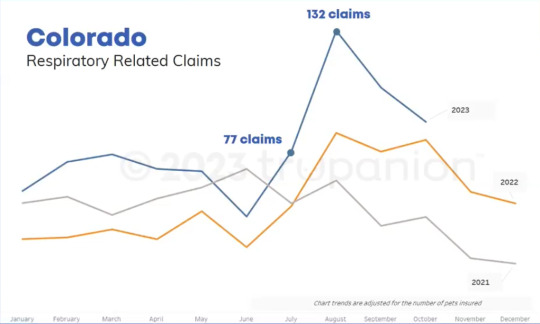
Credit: Trupanion
Note that the claims for 2022 and 2023 are not as diverse as one would expect based on the media coverage of the past couple of months. While there is no question that there was an uptick in claims in late summer of this year, it does appear to mimic what pediatricians and parents reported after their kids began mingling again.
Dr. Weese addressed the question of whether or not this might be a new pathogen in one of his blogs. Rather than rehash it here, I refer you to his excellent article, New Weird Canine Respiratory Pathogen? What Do We Know? Suffice it to say that he believes the "potentially novel organism" being investigated by the New Hampshire Veterinary Diagnostic Lab will probably not turn out to be a causative agent of this respiratory storm. Both he and Dr. Lappin thought that a truly new pathogen would sweep the country in a much more overt and obvious fashion.
What can you do to protect your pets?
All of the panel members were unanimous in recommending that the best preventative measure a dog owner can take is to vaccinate their dog(s) for the usual respiratory pathogens. The most common offender is Bordatella or kennel cough. There are also vaccines available for canine parainfluenza (CPIV) and canine influenza (CIV).
Bordatella and Parainfluenza are included in the 5-way vaccine that most puppies receive during their initial vaccination and that adult dogs receive in yearly booster shots. Also included in the 5-way vaccine is protection against an adenovirus that can contribute to CIRDC.
It is postulated that vaccine-induced immunity to parainfluenza likely lasts less than 3 years. Here is an excellent article that discusses parainfluenza virus and its role in CIRDC. This article stresses the role that parainfluenza virus plays in
weakening a dog's immune system and causing increased susceptability to other respiratory pathogens.
This AAHA article discusses the three most common causes of CIRDC. It is a very informative article but it is written for veterinarians and is very clinical. I will give you the Cliff's Notes version!

The canine influenza virus is a different pathogen than the parainfluenza virus. Two serotypes have been identified in North America. CIV is one of many pathogens that cause CIRDC: however, it has the potential to cause more severe disease than some of the other culprits.
CPIV is prevalent and often endemic in canine populations. Endemic means a disease that is always present in a population within a geographic area, typically year-round. CIV infections and clinical disease typically occur as multicentric and self-limiting outbreaks. Usually, vaccination against CIV is not recommended for the average family pet. Rather, dogs that are boarded and otherwise commingled at dog daycare, dog parks, dog shows and agility events, and dogs who travel should be vaccinated if an outbreak is occurring in their geographical area. Using a vaccine that includes both serotypes is preferable.
Should the "average family pet" receive a CIV vaccine during this surge in respiratory infections? My answer would be no, unless that pet has other conditions that might make it more susceptible to CIRDC. A "brachycephalic" dog, otherwise known as the squishy-faced breeds, would be a dog that might benefit from an influenza vaccine. Brachycephalic dogs are already predisposed to respiratory problems and would have a harder time recovering from CIRDC.
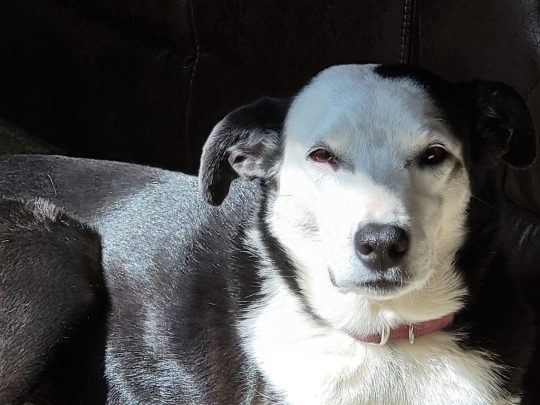
Old dogs and some immune-compromised dogs might be good candidates for CIV vaccination. However, one must weigh multiple variables. For instance, my old dog, Leah, has been diagnosed with Canine T-cell Lymphoma. Her age might qualify her as special needs, but her lymphoma diagnosis does the opposite. I have avoided vaccinating her and stimulating her immune system as her immune system is already "too hot." Talk with your veterinarian if you think your dog has special needs that might warrant a CIV vaccination.
Besides making sure that your dog is current on all relevant vaccines, another way to protect your pet would be to analyze the "cost-benefit ratio." Every time you expose your dog to other dogs, there is a risk. Remember all of the protocols that were in place for humans during COVID, and make similar decisions about where to take your dog. Decide if the benefit outweighs the potential cost.
The panel experts in the seminar discussed their clinic protocols for maintaining "biosecurity". Ask your groomer or your veterinarian what disinfecting protocols they practice. Drs. Weese and Lappen believed most veterinary clinics practiced good biosecurity and would be a safe destination for routine care. They did emphasize the importance of educating clients about not bringing sick dogs into the clinic's common areas. If your pet is sick, call ahead and make arrangements to enter through a side door or something similar.
DO NOT take a sick dog to a groomer, dog park, dog daycare, or other dog congregating facility. Just as we were expected to quarantine ourselves during COVID, you must have the same consideration for other dog owners and not expose their dogs to your sick pup. Dr. Weese wrote a great blog that provides sound advice to grooming facilities. Respiratory pathogens are spread by nose-to-nose contact, contact with secretions such as common dog bowls, and aerosolized droplets. COVID protocols called for 6 feet between people. Apply a similar restriction to your dog, perhaps increasing it to 10 feet or so.
When does a respiratory infection call for a trip to the vet?
If your dog is coughing but still eating and acting essentially normal, that is not a veterinary emergency. UPPER respiratory infections will often resolve on their own. Kennel cough caused by Bordatella is typically an UPPER respiratory infection. Dogs cough and honk like a goose, but they are generally not that sick. However, when an infection moves down into the lungs, that calls for veterinary intervention.
Dogs that are developing pneumonia will run a fever, be depressed, lose their appetite, and look like a miserably sick dog. Monitor your dog's respiratory rate. A normal rate is 15-30 breaths per minute. A dog that is struggling to move air will pant when not hot, stressed, or exercising. They may have to open their mouth to breathe or use more abdominal effort to inhale. If you suspect that your dog is heading down that path, don't waste time. Call your vet immediately.
What is an effective treatment?
Dr. Lappin recently participated in another panel that discussed CIRDC. Sixteen of the 17 panel members recommended doxycycline as the first line of defense against respiratory disease. The exception was if a dog had exposure to a horse, in which case the culprit might be a Strep bacteria. In that case, Amoxicillin would be the first drug of choice.
The panel members implored the pet parents who were participating in the seminar to not harass their veterinarians about getting antibiotics. Veterinarians may not prescribe antibiotics for a relatively mild infection where a dog is not that sick. Sometimes those infections are viral and antibiotics won't work anyway. It is not because your vet doesn't care, but rather because we know that microorganisms are increasingly resistant to our standard antibiotics. Please trust your vet to make the right decision about appropriate treatment.
Read the full article
0 notes
Text
CIRDC or Canine Infectious Respiratory Disease Complex... Is there A New Bug?
Media outlets of all types have been abuzz lately with growing public concern over the wave of respiratory disease seen in our canine companions. Is this a new disease or an uptick in canine infectious respiratory disease complex, or CIRDC? As a retired veterinarian, but one who is involved in shelter and rescue medicine, I wanted to get some straight answers from some of the respected…

View On WordPress
0 notes
Text
The Treacherous RMNP Trail You Don't Want to Take!

View On WordPress
0 notes
Text
Comanche Peak Wilderness, a Forest Rebounding From Fire
Finally, I am literally and figuratively back in the saddle. After a several month hiatus from blogging, and an even longer hiatus from riding, I am so happy to be able to share our recent trail rides with you! We enjoyed our first ride of the year in Comanche Peak Wilderness. My blog series about equine slaughter and my series about America’s wild horses really took a lot out of me. I needed a…

View On WordPress
0 notes
Text
BLM AMLs... And the Perilous Path to Extinction
Last week, I shared the wisdom of a couple of individuals who have significant insight into what is happening to America’s wild horse population. At the end of last week’s post, I teased you about the “BLM AMLs.” Before my eyes were opened about what is happening to America’s Mustangs, I had no idea about AMLs. What is an AML?
The BLM AML refers to what the Bureau of Land Management considers to…

View On WordPress
0 notes
Text
BLM Mustang Mismanagement
Just as I was incredibly naive when I started down the equine slaughter rabbit hole, I was equally naive about the BLM Mustang mismanagement mess. I have lived for over 6 decades, and I understand that counting on the government to get everything right is very foolish thinking. But I’m not a conspiracy theorist either… I don’t automatically assume that the government is corrupt and attempting to…

View On WordPress
0 notes
Text
Horse Slaughter Feedlots and Transport Atrocities
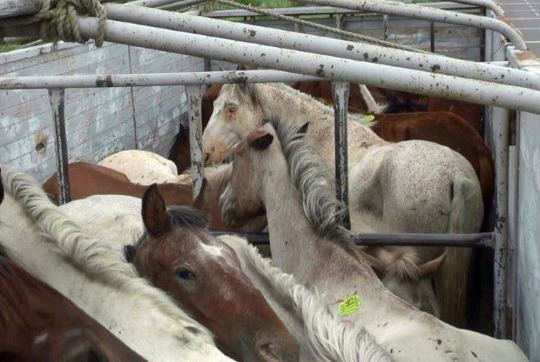
View On WordPress
0 notes
Text
An Investigation Into Horse Slaughter Auctions
Two weeks ago, I wrote about a hot-off-the-presses report detailing the plummeting numbers of horses subjected to slaughter in Mexico and Canada. The main point of that post was to make the very strong argument that the number of horses experiencing this cruelty is negligible in the scheme of managing the entire domestic equine population. In other words, while any number of horses having to…

View On WordPress
0 notes
Text
Planning to Visit the Southwest? Do You Know About Valley Fever?
I grew up in Indiana and attended Purdue University for my veterinary degree. We learned about diseases that affected animals all across the country, including fungal diseases. Histoplasmosis was more of a concern in the Midwest than Valley Fever. In fact, a staff member at my first job was tested for histoplasmosis when she gave birth to a child with multiple congenital diseases.
Now, Alan and…
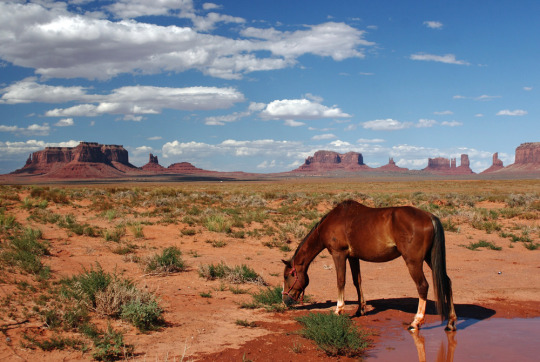
View On WordPress
0 notes
Text
A Simple Answer to All the Excuses for Supporting Horse Slaughter
It is past time to ban the slaughter of horses originating in the United States
It was a little less than 2 months ago that I began writing my series on horse slaughter and the auction pipeline scams. I have met some amazing people and organizations and learned some discouraging facts about others. The vast majority of readers have shared my thoughts and opinions and have expressed a real…

View On WordPress
0 notes
Text
Processing What I Have Learned About the Horse Auction/Slaughter Pipeline
I am starting this post in a coffee shop at the airport in Belize City in Central America. Alan and I spent a week hanging out at the beach, scuba diving (only once after 2 cancellations due to wind), and trying to survive the streets of San Pedro in a golf cart. While my mind was clear and I had no obligations, I spent some time processing my four posts about the horse auction/slaughter…

View On WordPress
0 notes
Text
A Healthy Healed Splint Bone Fracture...Time to Start Rehab!
Over the past four weeks, I have been writing a series about the equine slaughter/auction pipeline. Each post has taken hours or even days to write. I have spoken to countless people and read innumerable articles. It has been a labor-intensive and emotionally draining series. I will be writing more, and I have many ideas about related topics, but I need a break. This week, I bring you the good…

View On WordPress
0 notes
Text
Kettle Moraine Horse Camp in Wisconsin
Kettle Moraine Horse Camp in Wisconsin
As I mentioned at the end of last week’s post, we blew into Kettle Moraine Horse Camp mid-afternoon on a Thursday. We immediately got the horses settled into their corrals and headed an hour north to try and get our malfunctioning coach slide repaired. Alas, we were not successful. It has a date in November with the RV dealership…
When we arrived in camp, there were two other sites occupied. Two…

View On WordPress
0 notes
Text
The First Week Post-op & Regional Perfusion Explained
The First Week Post-op & Regional Perfusion Explained
Last week I wrote about my beloved Arabian gelding’s surgery at Colorado State University. I am very happy to report that as of this post, two weeks post-op, he is doing great. His leg is soft-splinted from his hoof to his chest. He moves around his tiny living space with ease. I was even able to get his very long and off-balance hooves trimmed recently.
Regional perfusion
In last week’s post,…

View On WordPress
0 notes